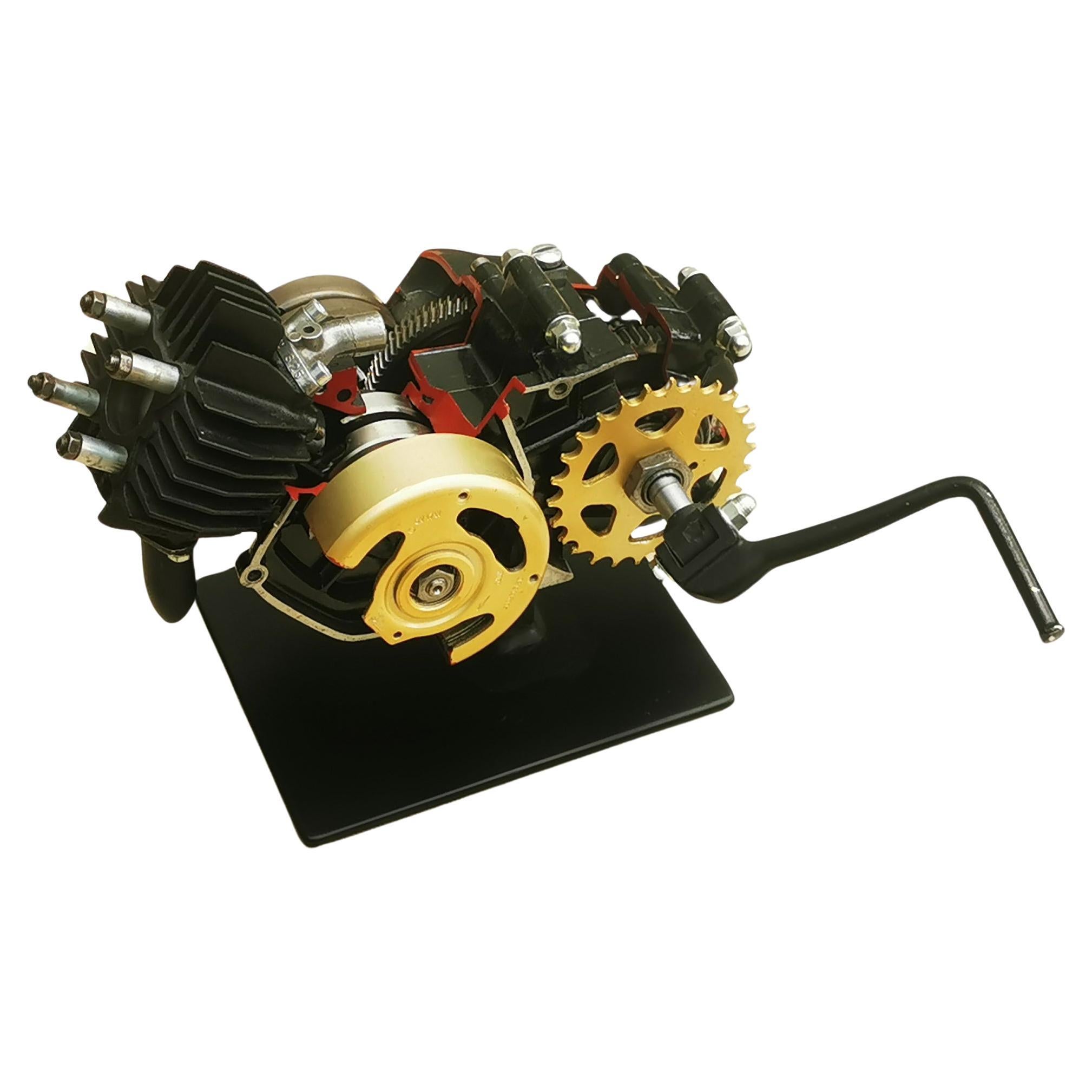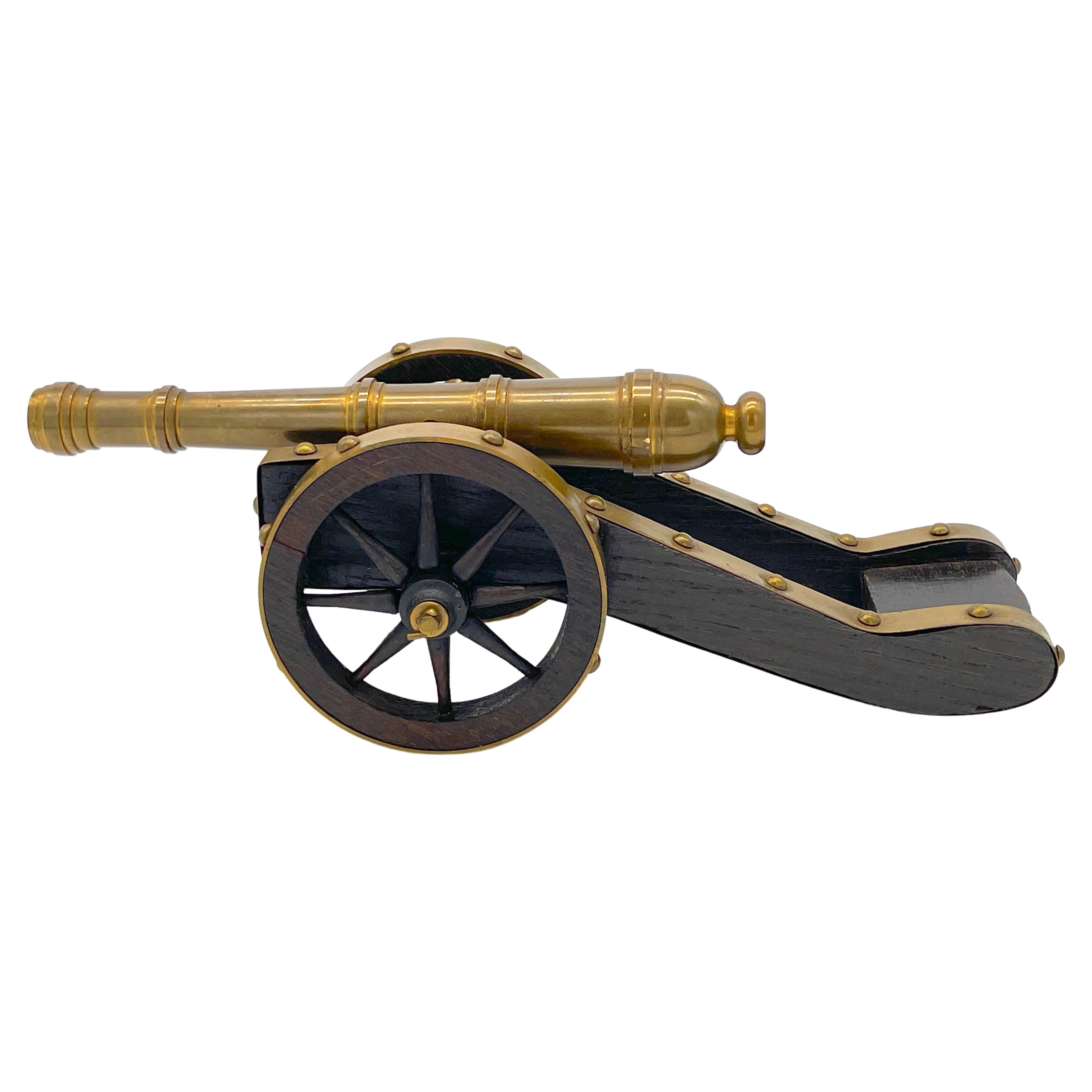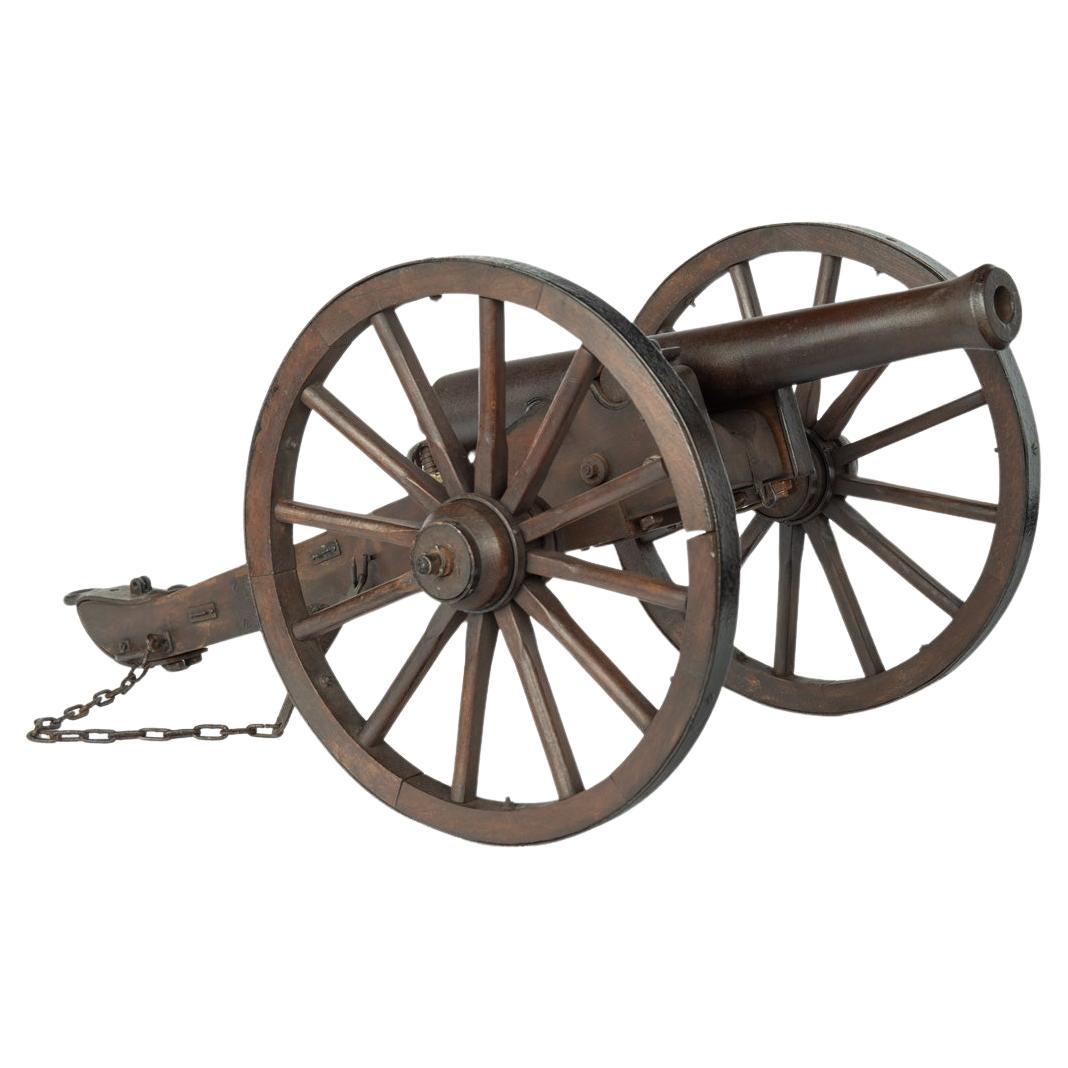Items Similar to A demonstration or museum model of a civil defence traversing cannon
Want more images or videos?
Request additional images or videos from the seller
1 of 17
A demonstration or museum model of a civil defence traversing cannon
About the Item
A demonstration or museum model of a civil defence traversing cannon. This bronze scale model of a defence cannon rests on a solid ebony carriage with working blocks and tackle to run the barrel out. It is set on a Derbyshire black marble base inset with a spoked pivot pin in the centre of a circular rail and a second curved rail for the two pairs of trucks to follow, thus allowing the gun to swivel or ‘traverse’ from side to side. It is mounted on its original walnut table with quadrant spandrels supported on four sturdy turned and reeded legs. There is a plaque reading ‘Model Carriage on Traversing Platform for Heavy Ordnance.’ English, circa 1847.
The gun represents a bronze smooth bore probably of the Napoleonic Wars period and afterwards up to around 1860. The carriage represents the type used for coast defence of the same period. Colonel John Tylden (commissioned 1819 – died 1866) would have witnessed the move from smooth bore to rifled artillery. It seems very likely that this model is related to a report by Colonel John Tylden (commissioned 1819 – died 1866) in 1847 about Archcliffe Fort in Dover ‘that the fort was armed with 6 x 32pdr guns mounted on traversing platforms, the masonry walls were in good order having the appearance of being recently restored. To aid the general artillery practice at the fort a 32pdr gun was mounted to fire over the rampart. 3 years later a local builder built an oak target to be used by the 12th Battalion Royal Artillery who were stationed at the Heights, it was moored a mile from shore and the local paper commented “that one shot passed through the mark.” Various Royal Artillery Battalions used the forts battery for practice, many of which were reported in the local papers, one such report read “unusually excellent” in 1852 when the 6th Battalion fired 240 rounds at the target, this was anchored 1000 feet away in the bay, the target was hit a total of 6 times.’
- Dimensions:Height: 45.5 in (115.57 cm)Width: 36.5 in (92.71 cm)Depth: 14.5 in (36.83 cm)
- Materials and Techniques:
- Place of Origin:
- Period:
- Date of Manufacture:1847
- Condition:Wear consistent with age and use.
- Seller Location:Lymington, GB
- Reference Number:1stDibs: LU973036137842
About the Seller
5.0
Recognized Seller
These prestigious sellers are industry leaders and represent the highest echelon for item quality and design.
Established in 1982
1stDibs seller since 2013
106 sales on 1stDibs
Typical response time: 4 hours
Associations
LAPADA - The Association of Arts & Antiques Dealers
- ShippingRetrieving quote...Ships From: Lymington, United Kingdom
- Return PolicyA return for this item may be initiated within 14 days of delivery.
More From This SellerView All
- Mid-Victorian Model of a Field CannonLocated in Lymington, HampshireA mid-Victorian model of a field cannon, the bronze barrel set on an oak carriage with large iron-bound wheels, with traces of the original black, red an...Category
Antique 1870s English Arms, Armor and Weapons
MaterialsBronze
- A late 19th century scale model of field cannonLocated in Lymington, HampshireA late 19th century scale model of field cannon, the barrel with a flared muzzle on an oak carriage with twin twelve spoke steel rimmed wheels and steel mounted body, a single ammuni...Category
Antique Late 19th Century European Arms, Armor and Weapons
MaterialsSteel
- A model of a Dockyard built teak and brass field cannonLocated in Lymington, HampshireA model of a Dockyard built teak and brass field cannon, with a brass barrel set on a brass-bound carriage with large wheels and a brass-bound bucket, swabs and ramrods to scale, fin...Category
Vintage 1930s English Arms, Armor and Weapons
MaterialsBrass
- Detailed Owner’s Model or Shipyard Model of a Double Ended Harbour LaunchLocated in Lymington, HampshireA detailed owner’s model or shipyard model of a double ended harbour launch, painted pale blue, the coach house with eight portholes, fitted with port and starboard lights...Category
Vintage 1940s English Models and Miniatures
MaterialsWood
- Pair of English Bronze Signal CannonLocated in Lymington, HampshireA fine pair of English bronze signal cannon, the tapering 36 inch two stage barrels set upon original mahogany carriages with bronze fittings and ...Category
Antique 1850s English Arms, Armor and Weapons
MaterialsBronze
- Pair of Antique English Naval CannonLocated in Lymington, HampshirePair of antique English naval cannon each with a tapering three stage barrel flanked by plain trunnions, with a knob shaped cascabel button before a shaped rectangular raised vent and ending in a 3 1/2” bore muzzle, enclosing a removable conforming wood plug, circa 1800. Stood upon a naval type bronze-mounted four wheeled wooden carriage, including its wedge shaped quoin with knob handle. The Earls of Lonsdale, Lowther Castle, Cumbria, presumably by descent to Hugh Cecil Lowther, 5th Earl of Lonsdale (1857-1944), until sold by his heir and brother, Lancelot, 6th Earl, as part of the contents of Lowther Castle, Maple & Co. Ltd./Thomas Wyatt, Tuesday 14 April 1947 and two following days, lot 558: ‘A pair of Old Gun Metal Cannons on teakwood carriages, 3ft. 6in. long’. Mrs. P.M. Adie-Shepherd, sold Christie’s, London, 29 May 1970, lot 96. Lowther Castle is a castellated mansion built by Robert Smirke between 1806 and 1814 for William Lowther, 1st Earl of Lonsdale (1757-1844). It was constructed on the foundations of the former 17th century family seat, Lowther Hall, but it was only in the early 19th century that it was afforded the name ‘castle’ in keeping with the Europe-wide fashion for romanticism and which was promoted by influential characters such as William Beckford at Fonthill Abbey, Wiltshire in England and by the writer Sir Walter Scott at Abbotsford, Roxburghshire, Scotland. While it’s not known when these naval cannon were acquired for Lowther they would have been entirely fitting in the castle or its approaches and it’s likely that they were in place soon after the castle was completed, or perhaps acquired later by the 5th Earl. A tantalising possibility is that the cannon were originally aboard the East Indiaman Lowther Castle which was active in the early 19th century. HUGH CECIL LONSDALE, 5TH EARL OF LONSDALE (1857-1944) AND THE DEMISE OF LOWTHER CASTLE In 1882 at the age of 25 Hugh Lonsdale (1857-1944) unexpectedly inherited the earldom and with it the extensive Lonsdale estate, including tens of thousands of acres of Cumberland and Westmorland and coalfields at Whitehaven. However, despite his spectacular inherited wealth – he was suddenly one of the wealthiest men in England, over the course of his lifetime he managed to decimate the family fortune. He led a full and colourful life, one of adventure and luxury. An early intrepid escapade took place in July 1888 when, as part of an expedition called the Scotch Naturalist Society, he set embarked on horse sleigh...Category
Antique Early 1800s English Arms, Armor and Weapons
MaterialsBronze
You May Also Like
- Demonstration Model Moped 60's Engine TomosLocated in VUGHT, NLVery exclusive and rare object for mancave, education or eye-catcher in an industrial interior. Made from start in 1954 by Tovarna Motornih Vozil in Yugoslavia. Originaly for the br...Category
Vintage 1960s Slovenian Models and Miniatures
MaterialsMetal
- French Bronze Cannon ModelLocated in New York, NYFrench bronze World War I (19/20th Century) field cannon on rectangular white marble baseCategory
Antique 1880s French Models and Miniatures
MaterialsMarble, Bronze
- English Brass & Wood Desk Top Model of a Signal CannonLocated in West Palm Beach, FLEnglish Brass & Wood Desk Top Model of a Signal Cannon England, circa 1950s An English brass & wood desk top model of a signal cannon, a mid 20th century example. This delightful...Category
20th Century English Models and Miniatures
MaterialsBrass
- Early 20th Century English Model of a Starting CannonLocated in London, GBThis well-proportioned to scale and detailed cast iron model of an English starting cannon features movable parts including the wheels and cannon barrel. It includes excellent detail...Category
Early 20th Century English Models and Miniatures
MaterialsIron
- Bronze and Iron Desk Signal Cannon ModelLocated in San Mateo, CAThis desk top signal cannon has a bronze barrel and iron carriage. This model will actually fire. The barrel has a nice patina. The base has been repaint...Category
Early 20th Century American Models and Miniatures
MaterialsIron, Bronze
- Museum Quality Model of American Steam Yacht HarvardLocated in Norwell, MAExpertly crafted model of George Baker's private steam yacht "Harvard". Baker helped found the Harvard business school in Cambridge and the Baker Library...Category
1990s American Models and Miniatures
MaterialsWood
Recently Viewed
View AllMore Ways To Browse
Napoleonic Bronze
Air Raid
Macintosh Computer Vintage
William Iv Strand Of Hair
Wwi Homefront Posters
All 12 Apollo Nasa Moonwalker
Ann Moris
Antique Absinthe Accessories
Antique Glass Bird Christmas Tree Ornaments
Antique Rolex Spoons
Cargo Bike
Copper Rum Cup
Freak Show Advertisement
Ge Fan
Hermes Indian Chief Scarf
Hermes Native American Indian Scarf
Hermes Pawnee Chief Scarf
John F Kennedy Campaign Poster





